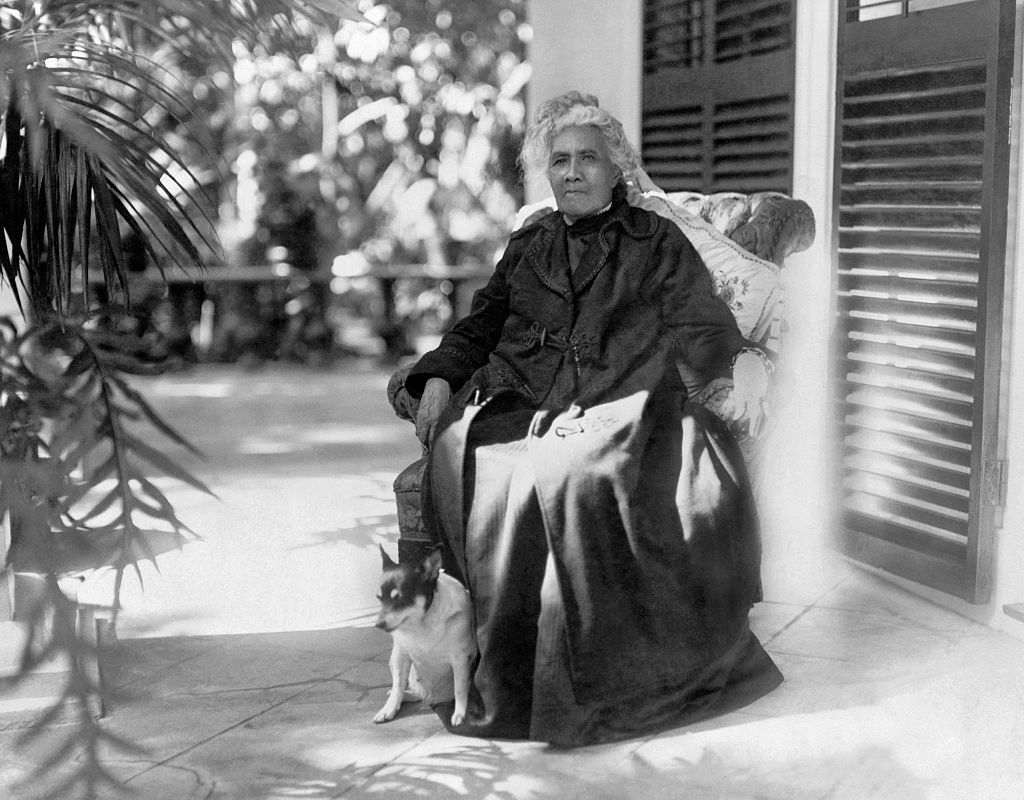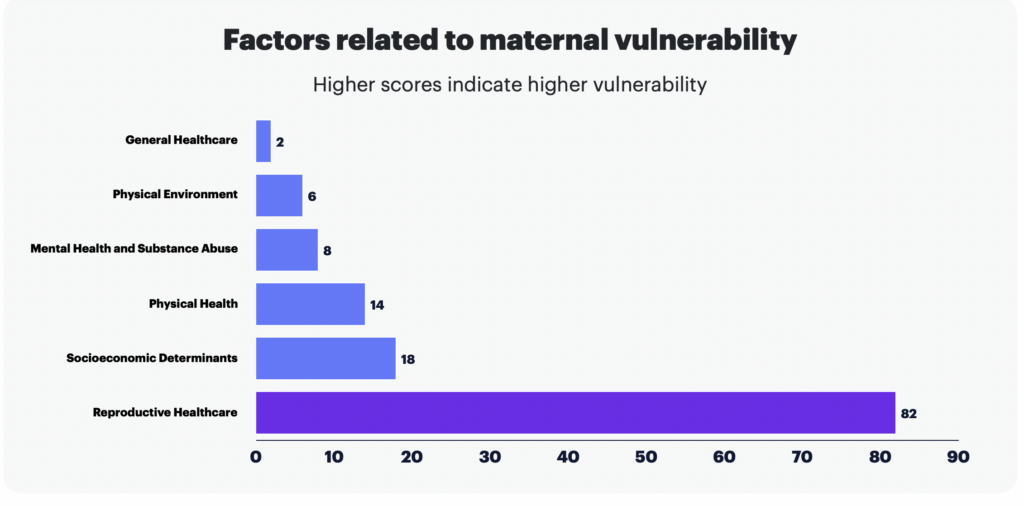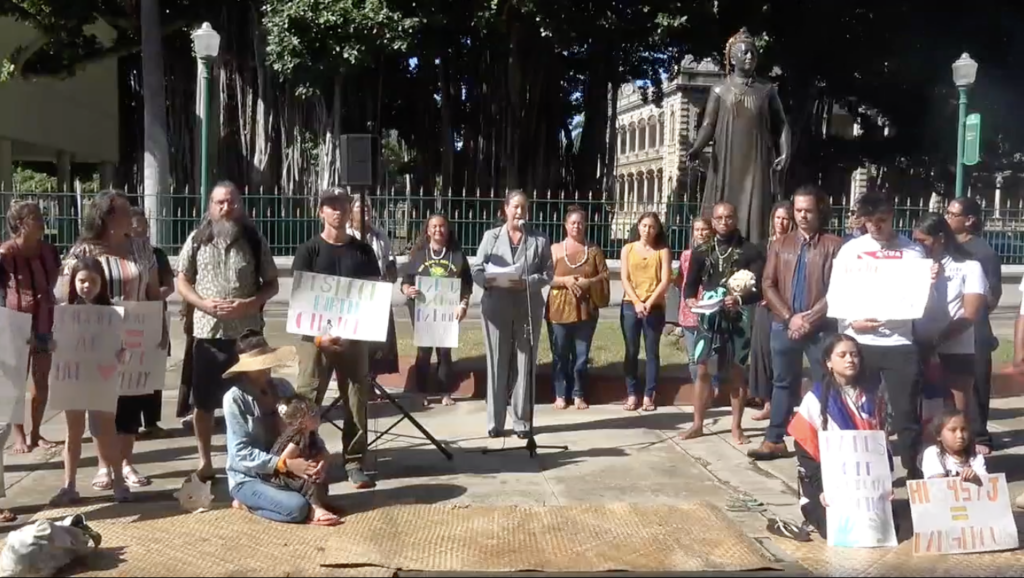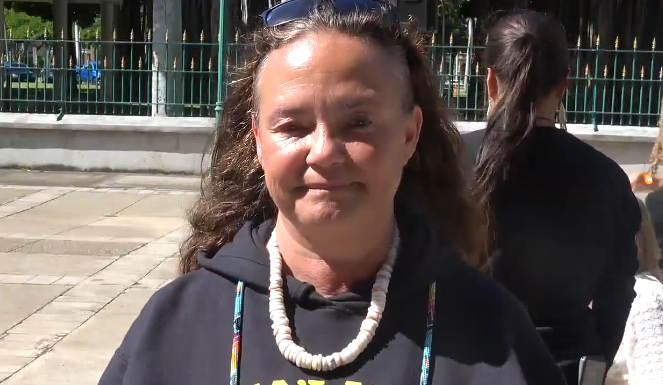Originally passed in the name of maternal and infant safety, Hawai‘i’s Midwifery Restriction Law is the subject of impassioned protests and a lawsuit brought on behalf of nine plaintiffs.

Update: On July 23, a state court issued a ruling for Kahoʻohanohano v. State of Hawaiʻi, allowing Native Hawaiian midwives to continue practicing pregnancy and birth care. The case was brought in February by the Center for Reproductive Rights on behalf of nine plaintiffs including midwives, midwifery students and other women affected by the law.
“Today, we are once again able to stand in our own ancestral knowledge and serve our community with skills and traditions passed down through generations,” said plaintiff Makalani Franco-Francis.
“Aloha, my name is Alia Stenback, and I’m an outlaw grandma. My criminal offense was catching my grandson.”
Two days after Alia Louise Stenback survived the Aug. 8, 2023, wildfire in Lāhainā, Maui—the deadliest wildfire the United States has seen in over 100 years—she parked herself at a medical tent. One month later, with no ambulances around to provide transport to a hospital, her grandson was born. With a donated birthing kit and the support of traditional midwives, Stenback “caught [her] grandson.” (Notably, many midwives, doulas and traditional birth practitioners believe the mother or birthing person “delivers” the baby—the helpers merely “catch” it.)
Stenback grants herself “outlaw” status because she provided care during labor without a midwifery license, in assumed violation of Hawai‘i’s HRS §457J, otherwise known as the Midwifery Restriction Law. Passed in 2019, the law prohibits anyone who does not have a state-issued license from practicing “midwifery,” broadly defined as providing advice, supervision or care during pregnancy, birth or the postpartum period. The law allowed a “grace period”; unlicensed birth attendants had until July 1, 2023, to gain necessary certification. Many never did—and now fear criminal consequences.
Some of those who remain unlicensed are those like Stenback, grandmothers or extended family members for whom the law makes no exception. Indeed, a clarification letter from the attorney general of Hawai‘i revealed last month that even when no money exchanges hands, only state-licensed midwives or immediate family members can give “midwifery” support, as defined by the law during pregnancy, birth or its aftermath.
Others who remain unlicensed work as pale keiki, a midwife who uses centuries-old Native Hawaiian birthing practices, or kahuna lāʻau lapa‘au, a traditional medicinal healer. Pale keiki and kahuna lāʻau lapa‘au may train through apprenticeship, receiving inherited wisdom and traditional training from other practitioners. Yet, the Midwifery Restriction Law does not recognize this type of apprenticeship as a proper basis for state-issued licenses.
The law’s midwifery licensing scheme has only produced 29 licensed midwives. None are Native Hawaiian, and many do not even practice in Hawai‘i, which leaves pregnant residents of Hawai‘i without legal options for traditional care from Native practitioners.
Midwifery Restriction in Hawai‘i
The Midwifery Restriction Law finds itself at the center of layered controversy about Native Hawaiian sovereignty, maternal health and reproductive autonomy (the right to choose where and with whom to give birth). Originally passed in the name of maternal and infant safety, the law is the subject of impassioned protests, new legislative proposals and a lawsuit filed by the Center for Reproductive Rights and the Native Hawaiian Legal Corporation.
When Hawai‘i was still an independent country—before Queen Liliʻuokalani’s reign over the Hawaiian kingdom was cut short by a white-settler-led coup in 1895—Native Hawaiian healing practices were passed freely from generation to generation.

Shortly after the U.S.’ 1898 annexation of the islands, the U.S.-installed territorial government banned Native healing customs, including birthing practices.
In 1941, the same government decided that only certified nurse midwives could practice midwifery, mimicking the policy in many states throughout the continental U.S. that pushed non-white practitioners out of midwifery (by excluding them from the training institutions required for certification).
After Hawai‘i became the 50th state, a Hawaiian cultural renaissance began, and Native Hawaiians started reintegrating and reclaiming the cultural traditions colonialization pushed underground.
In 1978, citizens of Hawai‘i voted to approve an amendment to the state Constitution, now Article XII, Section 7, promising that the state “shall protect all rights, customarily and traditionally exercised for subsistence, cultural and religious purposes” of Native Hawaiians “subject to the right of the State to regulate such rights.”
In 1998, the state of Hawai‘i repealed the licensure mandate for midwives. For the next 24 years, traditional midwives could practice and train others openly.
The Midwifery Restriction Law
The Midwifery Restriction Law’s stated findings and purpose show that Hawai‘i legislators regulated midwifery because, they wrote, the “improper practice of midwifery” might lead to “significant risk of harm to the mother or newborn, and may result in death.” Indeed, leading up to the law’s passage, lawmakers heard testimony from organizations of concerned practitioners; the Hawai‘i branch of The American College of Obstetricians and Gynecologists (ACOG), for instance, strongly supported the law’s licensing scheme because they favor standards for all maternity care. Even though lawmakers heard testimony from groups concerned that the law’s broad definition of midwifery would restrict traditional and cultural practices, they passed it without substantial edits.
The law’s three-year “grace period” exempting “birth attendants,” unlicensed individuals who provide support or care during pregnancy, birth or postpartum, meant to not only allow birth attendants to get licenses when necessary but also give the legislature time to, in the law’s words, “enact statutes that will incorporate all birth practitioners and allow them to practice to the fullest extent under the law.”
Six months before the exemption expired, a state representative introduced HB 955, a bill that would have extended the exemption—allowing traditional midwives and others to continue practicing—and would have reopened a more traditional, apprenticeship-based pathway to licensure. The bill stalled in the House Finance Committee, where the chair, Rep. Kyle Yamashita, continues to deny HB 955 a hearing.
Under the current Midwifery Restriction Law, obtaining a midwifery license falls under a few paths.
- In order to obtain a license, one must prove to the Hawai‘i Department of Commerce and Consumer Affairs that they are either a “certified midwife” (CM) or a “certified professional midwife” (CPM). CMs and CPMs are classified as “direct-entry midwives”; unlike nurse-midwives, their training provides for non-hospital settings. There are currently no CMs working in Hawai‘i.
- The only other pathway to licensure is through the Board of Nursing, which is not covered by the Midwifery Restriction Law, but that road is only open to those trained as a “certified nurse-midwife” (CNM).
Typically, to become a CPM, a student midwife may work as an apprentice for a credentialed midwife or attend a school recognized by the Midwifery Education Accreditation Council (MEAC). There are only eight MEAC institutions in the United States, and none are located in Hawai‘i. Four programs offer entirely remote courses, but they require money and Wi-Fi, both of which can be prohibitive.
House Bill 955
With unlicensed birth attendants unavailable, those giving birth in Hawai‘i do not have an option to work with a Native Hawaiian midwife (none of the 29 CPMs licensed under this law are Indigenous and familiar with traditional birthing customs). HB 955 would allow traditional midwives to keep working, and by reopening the apprenticeship route to CPM credentials, it would grant more midwives a path to licensure.
According to the Honolulu Civil Beat, HB 955 received significant support just within three months of its introduction; lawmakers received testimony from “hundreds,” including the Hawai‘i State Commission on the Status of Women, which called the 2019 Midwifery Restriction Law “an overcorrection for public safety.” The commission wrote that the law neglected to take into account that “[t]he fight for ‘my body, my choice’ should extend to a woman’s decision where and how to give birth and access to more involved care, especially in light of negative outcomes linked to medical sexism and racism in the United States.”
HB 955 would allow traditional midwives to keep working and … would grant more midwives a path to licensure.
But ACOG, some physicians and some midwives with state-issued licenses oppose HB 955, and legislators are following their lead. Notably, some of these opponents, like Le‘a Minton, president of the Midwives Alliance of Hawai‘i, believe that birth attendants and cultural practitioners can still practice under the Midwifery Restriction Law. Last month, the attorney general confirmed that all birth attendants are banned from practicing after July 1, 2023. Anyone who practices midwifery as defined by the law without a license became subject to fines up to $2,000 and imprisonment for a maximum of one year.
Fighting the Midwifery Restriction Law
Now, over eight months later, traditional midwives are taking to the courts.
On Feb. 27, the Center for Reproductive Rights (CRR) and the Native Hawaiian Legal Corporation filed a complaint in state court challenging Hawai‘i’s Midwifery Restriction Law. Hillary Schneller, a senior staff attorney at CRR, said, “The law has had a really devastating impact in particular on Native Hawaiian midwives and families of color, really preventing pregnant people in Hawai‘i from using skilled midwives for their pregnancies and birth.”
The case involves nine plaintiffs: midwives who provide traditional and culturally informed care (licensed and unlicensed), their students and Native Hawaiian women who used or want to use traditional midwifery services during pregnancy, birth and the postpartum period. The complaint alleges that the Midwifery Restriction Law interferes with the plaintiffs’ state constitutional rights, violating provisions related to the protection of Native Hawaiian customs and reproductive autonomy and is impermissibly broad.
“The law may have had good intentions,” Schneller said, and “there are improvements that can be made to the law, [but] in the meantime, it is causing incredible harm. So we’ve asked the court to block the penalties under the law against our clients who have been serving their communities in Hawai‘i for years.”
One of their clients is Ki‘inaniokalani Kaho‘ohanohano, a Native Hawaiian pale keiki who engaged in traditional birthing practices for two decades before the Midwifery Restriction Law’s exemption expired. In a press release from the Native Hawaiian Legal Corporation (NHLC), Kaho‘ohanohano said the law “is robbing the next generation of Native Hawaiians of our own ancestral healing knowledge and power.”
Cutting off our ability to care for our families with our own traditions and practices is medical colonialism.
Ki‘inaniokalani Kaho‘ohanohano
To the people Kaho‘ohanohano serves, home births allow them to “reclaim and perpetuate sacred and cultural practices,” as the complaint says.
Sometimes, it can also make them feel safer. “Our communities are experiencing a maternal health crisis in hospitals,” she said in the press release, “and cutting off our ability to care for our families with our own traditions and practices is medical colonialism.”
Pregnancy and Birth in the U.S. and Hawai‘i
Native Hawaiians and other Pacific Islanders are 4.5 times more likely to die from pregnancy-related causes than their white counterparts, according to CDC data from 2017 to 2019. In Hawai‘i specifically, even though Native Hawaiians and Pacific Islanders comprise 22 percent of the population of Hawai‘i, they account for 44 percent of Hawai‘i’s pregnancy-related deaths.
In the United States generally, 98.4 percent of births take place in hospitals. The numbers in Hawai‘i look the same: in 2017 and 2018, the two years before the Midwifery Restriction Law was passed, only around 1.7 percent of births were planned home births. None of them resulted in maternal or infant deaths.
Most births in Hawai‘i during that time occurred in hospitals, where medical intervention during birth is common. As the complaint explains, medical interventions—from episiotomies to cesarean sections—are often necessary. But when unnecessary, birth interventions can raise the risk of complications during delivery. Citing a Hawai‘i State Department of Health fact sheet, the complaint explains that a cesarean section, for instance, “is the most common major surgery performed in the United States and results in higher costs, longer hospitalization and increased risks of maternal morbidity compared to women who deliver vaginally.”

Some women and others who give birth find that they lack a voice in the hospital context. Ezinne Dawson, another one of the nine plaintiffs in the suit against the Midwifery Restriction Law, said in the NHLC press release that she “went through three stressful and disempowering hospital births, so for [her] fourth child, [she] decided to do a home birth.”
Reports suggest that mistreatment during pregnancy and birth in hospital systems is particularly acute for Indigenous women and women of color. According to the complaint, Dawson—one of the state’s two licensed Black midwives, and one who trains others via apprenticeship—aims to “diversify the midwifery profession” and advance maternal health for marginalized patients.
ACOG and other physician organizations that continue supporting the Midwifery Restriction Law maintain that a hospital setting is the safest for delivery. But, as the lawsuit explains, Hawaiians living in rural areas are often far from hospitals; all of O’ahu’s five hospitals that have labor and delivery units are on the south of the island, around an hour-long drive from those living on the north side. The one hospital on Maui is a two to three hour car ride from the eastern side of the island.
The complaint says that sometimes, “pregnant people give birth on the side of the road, en route to the hospital” because of tourist congestion on the only “winding road” available.
Those on other islands face similar or additional barriers. There is no hospital with a labor and delivery unit on Lāna‘i, which forces all of its pregnant residents to fly to another island that could provide care in order to give birth in a hospital or birth center. The complaint explains that individuals who cannot make it to a hospital—or do not want to go to a hospital—turn to local midwives or extended family, any of whom could face criminal consequences under the current law.
Taking Action to Protect Reproductive Autonomy
The choices at the center of this case, Schneller said, are about reproductive autonomy.
“I think people connect to that abortion is an issue of reproductive rights,” she said, “but it is also very much about the ability to make other decisions during pregnancy and birth … and piecing that all together as part of a robust right to reproductive autonomy is critical.”

On Feb. 29, two days after the complaint was filed, a group associated with the Pacific Birth Collective gathered at the state Capitol for a press conference about the lawsuit. Livestreamed on Facebook, the event featured planned and unplanned speakers, from the head of the Hawai‘i ACLU and a former state senator, to aspiring traditional midwives and men who helped their partners through home births.

They spoke about personal experiences with Indigenous birthing practices, which had been lost for decades, and the importance of the right to choose where and with whom to give birth. All the while, they stood in front of a statue of the last Hawai‘ian queen.
As the press conference drew to a close—as they started moving to drop off copies of the recently filed complaint into the hands of state representatives—Alia Stenback came to the camera to speak about the birth of her grandson, who would not be alive without unlicensed birth attendants, including herself.
“I’m an outlaw grandma,” she said, “I caught my grandson.”
Up next:
U.S. democracy is at a dangerous inflection point—from the demise of abortion rights, to a lack of pay equity and parental leave, to skyrocketing maternal mortality, and attacks on trans health. Left unchecked, these crises will lead to wider gaps in political participation and representation. For 50 years, Ms. has been forging feminist journalism—reporting, rebelling and truth-telling from the front-lines, championing the Equal Rights Amendment, and centering the stories of those most impacted. With all that’s at stake for equality, we are redoubling our commitment for the next 50 years. In turn, we need your help, Support Ms. today with a donation—any amount that is meaningful to you. For as little as $5 each month, you’ll receive the print magazine along with our e-newsletters, action alerts, and invitations to Ms. Studios events and podcasts. We are grateful for your loyalty and ferocity.





